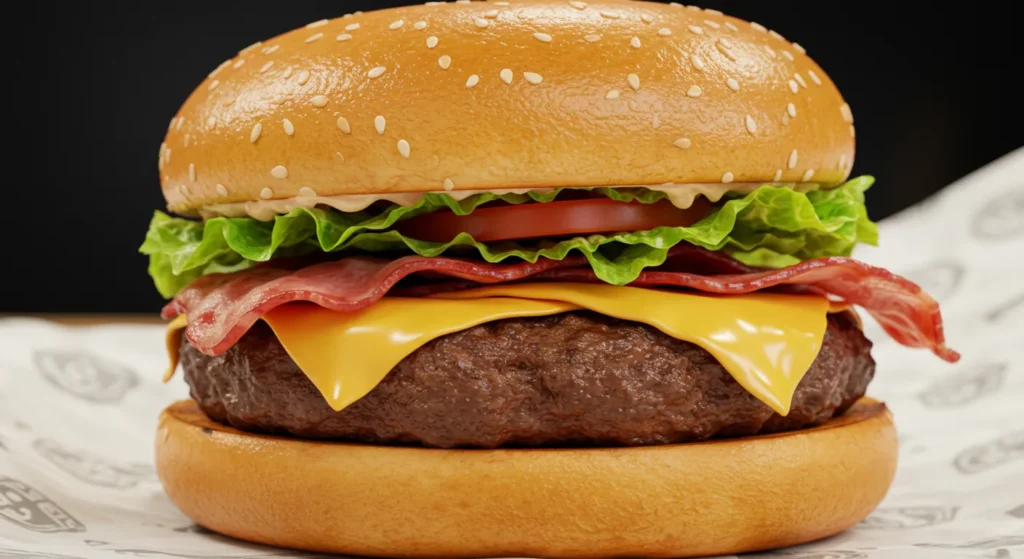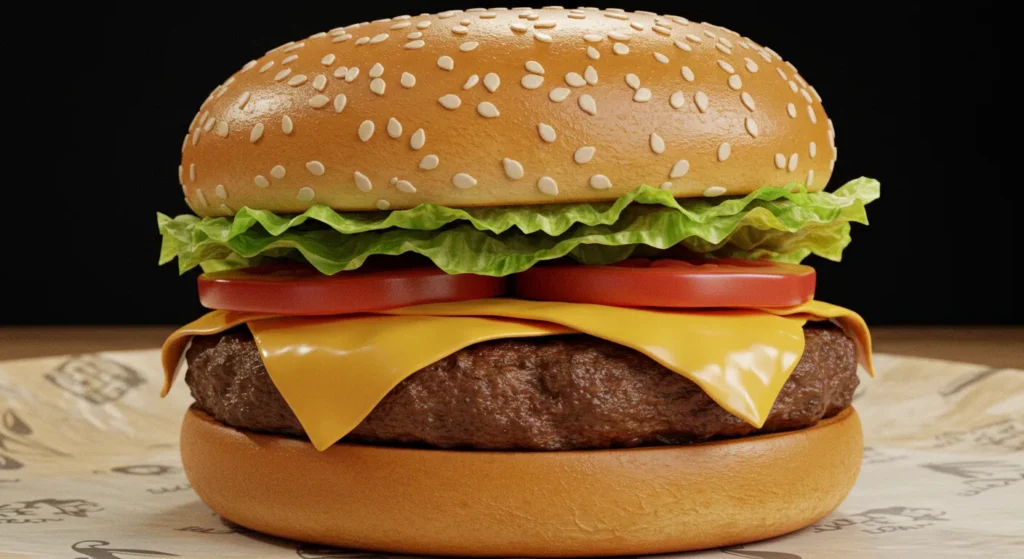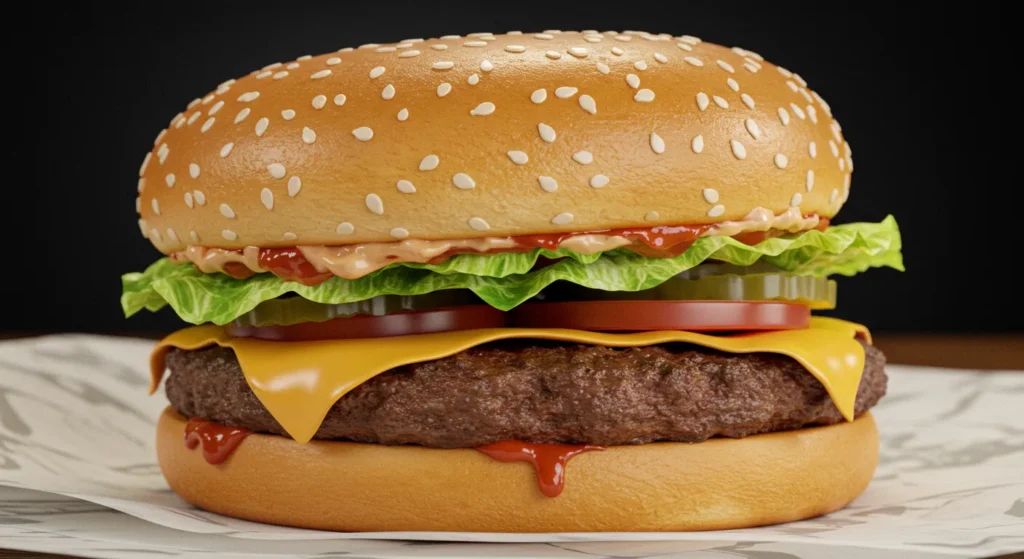
Table of Contents
It’s a summer evening in 1896. The Chicago Daily Tribune has a great ad. It’s for a “Hamburger steak sandwich” for just five cents. This simple ad started a big change in American food.
The hamburger is more than food. It’s a big deal in our culture. It’s loved at county fairs and in city diners. Many people think it was invented in the late 1800s.
Exploring hamburgers shows a lot of creativity. Charlie Nagreen made a meat patty sandwich at a fair. Fletcher Davis added mustard and onions in Texas. Each story adds to the tasty story of American food.
Key Takeaways
- Hamburgers became a hit fast food in late 19th-century America
- Many people say they invented the hamburger
- It quickly became a favorite in America
- Early hamburgers cost as little as five cents
- The St. Louis World’s Fair in 1904 made hamburgers famous everywhere
Origins of the Hamburger: From Hamburg to Global Icon
The journey of the hamburger is a fascinating story. It spans continents and centuries. This dish has a rich history, blending global food traditions and new cooking ways.
The story starts in Hamburg, Germany. Here, the modern hamburger patty was born. German immigrants brought this dish to America by the late 1800s. It changed global food forever.
German Roots and Etymology
Exploring the hamburger’s origins is interesting:
- The first mention of Hamburg steak was in 1873 at Delmonico’s Restaurant
- It cost 11 cents, more than a simple beef fillet
- By 1887, it was a hit in New York restaurants
Evolution into Modern Sandwich
Technology helped the hamburger grow. Meat grinders from the early 1800s made patties easier to make. This made them more consistent and accessible.
“The hamburger is not just a meal, it’s a cultural phenomenon that represents American innovation and culinary creativity.”
Early American Adaptations
American chefs loved the hamburger. They made it a favorite across the country. The 1904 St. Louis World’s Fair helped it become more famous.
By 1930, “hamburger” was the only name used. It became a big part of American food, ready for the world.
Essential Ingredients for the Perfect Hamburger
Making a great hamburger starts with picking the right stuff. The main thing is the ground beef, which is the burger’s heart. Let’s look at what makes a meal special.
- Ground Beef: The foundation of any great burger
- Burger Bun: The critical supporting player
- Seasonings: Salt and pepper
- Optional toppings and condiments
For ground beef, choose the 80/20 lean-to-fat mix. It’s juicy and full of flavor. Ground chuck is the best choice for a moist burger.
| Ingredient | Recommended Specification |
|---|---|
| Ground Beef | 80/20 lean-to-fat ratio (Ground Chuck) |
| Burger Bun | Sesame Seed Bun (Classic Choice) |
| Patty Thickness | ½ inch thick |
The bun is key for a good burger. A sesame seed bun is soft but crunchy. It should match the meat’s flavor.
“A great burger is all about balance – from the meat to the bun, every ingredient matters.” – Burger Enthuasiast
Tip: Make patties 1 inch wider than the bun. This helps them fit perfectly after cooking.
Classic Hamburger Construction Techniques
Making the perfect hamburger is like art. It needs precision and skill. From picking the right meat to shaping the patty, every step is key.
The best hamburger starts with the right meat. I like using 80/20 ground chuck. It’s juicy and full of flavor.
Meat Selection Strategy
- Choose ground chuck with 80% lean meat and 20% fat
- Avoid overly lean meats that can result in dry burgers
- Consider alternative meats like bison or lamb for unique flavors
Patty Formation Techniques
When making your patty, be gentle. Make a 6-ounce patty with a slight dent in the middle. This helps it cook evenly.
- Handle meat minimally to prevent tough texture
- Use your thumb to create a shallow well in the center
- Season generously with salt and pepper on both sides
Temperature Control Mastery
Cooking temperature is key. Use high heat for about 3 minutes per side. Let it rest for 3-4 minutes to keep it juicy.
“The secret to a great burger is respecting the meat and understanding its cooking process.” – Professional Chef
Mastering these techniques will make your burgers amazing. They’ll impress everyone at your table.
The Art of Seasoning and Flavoring
Making the perfect burger is like art. Seasoning is key to making it special. I learned that the right mix of spices can make a simple burger amazing.
Seasoning needs to be precise. I use a special seasoning mix for my burgers. Here’s what’s in it:
- ½ tsp sweet paprika
- ¼ tsp smoked paprika
- ½ tsp onion powder
- ½ tsp garlic powder
- ¼ tsp freshly cracked black pepper
- ⅛ tsp cayenne pepper
- ½ tsp salt
Seasoning is all about balance. Too little seasoning makes burgers taste bland. Pro tip: Be generous with your seasoning! For a ¼ lb burger, use ¼ to ½ teaspoon on each side.
“Seasoning is the difference between a good burger and a great burger.” – Grill Master’s Wisdom
Condiments add more flavor. While ketchup and mustard are classics, try new things. I love making unique condiment mixes that excite people.
| Seasoning Cost | Amount |
|---|---|
| Total Seasoning Blend Cost | $0.33 |
| Patties per Blend | 4 burgers |
Whether you’re a pro or just starting, learning seasoning will make your burgers better. Remember, cooking is about trying new things and finding what you like!
Cooking Methods and Temperature Guidelines
Learning to cook hamburgers is all about different ways and keeping the right temperature. You can use a barbecue grill or kitchen tools. Each way needs careful attention to make the burger just right.
Essential Temperature Safety Guidelines
Keeping food safe is very important when making hamburgers. The FDA and CDC give us important tips:
- Recommended internal temperature: 160°F
- Minimum cooking time: 17 seconds at 155°F
- Eliminates harmful bacteria like E. coli
Grilling Techniques for Perfect Burgers
Grilling on a barbecue grill gives the best taste. Here are some important things to remember:
- Preheat grill to medium-high heat (350-400°F)
- Cook patties 3-4 minutes per side
- Use a meat thermometer for accuracy
Alternative Cooking Methods
If you don’t have a barbecue grill, don’t worry. Here are other ways to cook:
| Cooking Method | Temperature | Cooking Time |
|---|---|---|
| Stovetop Skillet | 375°F | 4-5 minutes per side |
| Oven-Baked | 400°F | 15-20 minutes |
Pro Tips for Burger Perfection
Here are my best tips for making burgers like a pro:
- Let burgers rest 3-5 minutes after cooking
- Use a digital instant-read thermometer
- Aim for 15-20% fat content in ground beef
“The secret to a great burger is not just the meat, but mastering temperature and technique.”
Popular Hamburger Variations and Styles

Hamburgers are a big hit in fast food. They come in many tasty styles. Burger fans have lots of choices now.
There’s more to hamburgers than just beef. Let’s explore some fun burger styles that people love:
- Cheeseburgers: A classic favorite, with about 50% of people loving it
- Veggie burgers: They’re getting more popular, making up 40% of burgers in cities
- Specialty burgers like the Juicy Lucy, with special meat mixes
- Regional burgers that show off local tastes and ingredients
Fast food places like McDonald’s and Burger King have made their own famous burgers. These burgers have become big names. The plant-based burger market has also grown a lot, hitting $1.1 billion in North America by 2023.
“A great burger is an art form, combining perfect meat, creative toppings, and culinary passion.” – Anonymous Chef
Some new burger trends include:
- Elk burgers are getting popular in Canada
- Turkey burgers with special flavors
- Seafood burgers like shrimp burgers
- Gourmet burgers with fancy cheeses like Comté
Whether you like meat or plant-based, there’s a burger for you!
Essential Toppings and Condiments
Making a great burger is more than just a patty. The right toppings and condiments make it special. Let’s explore the best toppings for a better burger.
Traditional Garnishes that Shine
Classic condiments are key to great burger flavor. Here are my favorites:
- Fresh tomatoes (perfect in summer)
- Crisp lettuce leaves
- Thinly sliced onions
- Bread and butter pickles
Signature Sauce Combinations
Being creative with condiments is important. Here are some amazing sauce blends:
| Sauce Name | Key Ingredients | Flavor Profile |
|---|---|---|
| Sweet BBQ Fusion | Tomato sauce, yellow mustard | Rich, tangy |
| Ghost Pepper Ranch | Ranch, ghost pepper sauce | Spicy, creamy |
| Sriracha Mayo | Mayonnaise, sriracha | Spicy, smooth |
Global Topping Inspirations
Try these international toppings for a new taste:
- Jalapeños (fresh or pickled)
- Avocado slices
- Bacon (loved by all)
- Crispy onion rings
Pro tip: Add pickle juice to your bun for a unique touch!
Whether you love classic or new flavors, these toppings and sauces will wow your guests.
Bun Selection and Preparation

Choosing the right burger bun is an art. It can make or break your hamburger. The perfect bun is more than just a bread holder. It’s key to a great meal.
When picking a bun, think about these things:
- Texture that goes well with the patty
- Ability to soak up juices without getting soggy
- Flavor that makes the burger taste better
The sesame seed bun is a favorite for many. It has a nutty taste and soft feel. It’s perfect for both simple and fancy burgers.
Bun Preparation Techniques
Toasting a bun can make it amazing. Lightly butter it and toast it quickly. This makes the outside crispy and keeps the inside tasty.
| Bun Type | Characteristics | Best Paired With |
|---|---|---|
| Sesame Seed Bun | Nutty flavor, soft texture | Classic beef burgers |
| Brioche Bun | Rich, buttery taste | Gourmet burgers |
| Potato Bun | Soft, dense texture | Juicy, thick patties |
“A great burger starts with a great bun” – Chef’s Secret
Pro tip: Make sure your bun is fresh and warm. The right bun can turn a good burger into an unforgettable one.
Common Cooking Mistakes to Avoid
Making the perfect hamburger patty needs skill and care. Many home cooks make simple mistakes that ruin their burgers. These mistakes can change the taste and feel of the burger a lot.
When you work with ground beef, some big mistakes can hurt your burger:
- Overworking the meat, which makes it tough
- Not making patties right, leading to uneven cooking
- Not seasoning right
- Not controlling the heat well
“The difference between a good burger and a great burger is in the details.”
Ground beef needs careful handling. Overmixing makes the patty dense and chewy. Chefs say to handle the meat as little as possible when making patties.
| Mistake | Consequence | Solution |
|---|---|---|
| Overworking meat | Tough burger texture | Gentle mixing, minimal handling |
| Incorrect fat ratio | Dry or flavorless burger | Use 80/20 ground beef blend |
| Premature salting | Moisture loss | Salt just before cooking |
It’s key to manage the temperature right. Let the ground beef get to room temperature before cooking. Don’t press down on patties while grilling. A small dimple in the center helps cook evenly and prevents bulging.
Knowing these common mistakes helps make your hamburger patties amazing.
Conclusion
We’ve explored the tasty world of hamburgers. We looked at their history and how to make them. You now know how to make great burgers at home.
Making a great burger is more than just following a recipe. It’s about getting the flavors and textures right. Whether you’re grilling at home or in the kitchen, you can make amazing burgers.
The best burgers come from passion and trying new things. Don’t be shy to try new ingredients and toppings. Hamburgers are a way to share food and make memories.
Now it’s your turn to make your own amazing burgers. Get your grill ready and start cooking. Your perfect burger is waiting for you!
FAQ
What is the origin of the hamburger?
The hamburger comes from Hamburg, Germany. It started as a chopped steak. German immigrants brought it to the U.S., where it became the burger we love today.
What’s the best type of ground beef for hamburgers?
Use ground beef with 80/20 fat content. This makes burgers juicy and tasty. Chuck beef is the best for flavor and texture.
How do I prevent my hamburger patties from falling apart?
Handle the meat gently and don’t overwork it. Make a dent in the middle of each patty. Chill them for 15 minutes before cooking. Use a light touch when forming and flipping.
What’s the ideal cooking temperature for hamburgers?
Cook burgers to 160°F for well-done. Use a meat thermometer for safety. For medium, aim for 140-145°F. For medium-rare, 130-135°F. Ground beef needs thorough cooking to be safe.
How can I make my hamburgers more flavorful?
Try seasoning blends like salt, black pepper, and garlic powder. Add Worcestershire sauce for depth. Fresh herbs like parsley or chives also work well. Don’t be afraid to try new spice blends or marinades.
What are the best buns for hamburgers?
Classic sesame seed buns are great, but try artisan bakery buns too. Brioche buns are rich and buttery, while potato rolls are soft and sweet. Toast your buns lightly to add texture.
How do I achieve the perfect burger crust?
Make sure your cooking surface is hot before adding the patty. Use a cast-iron skillet or grill. Let the patty sear undisturbed for 3-4 minutes on each side. Avoid pressing down on the burger.
Are there good alternatives to beef hamburgers?
Yes! Try plant-based burgers like Beyond Meat and Impossible Burger. Turkey, chicken, and salmon burgers are leaner. For vegetarians, black bean, portobello mushroom, and lentil patties are tasty options.

